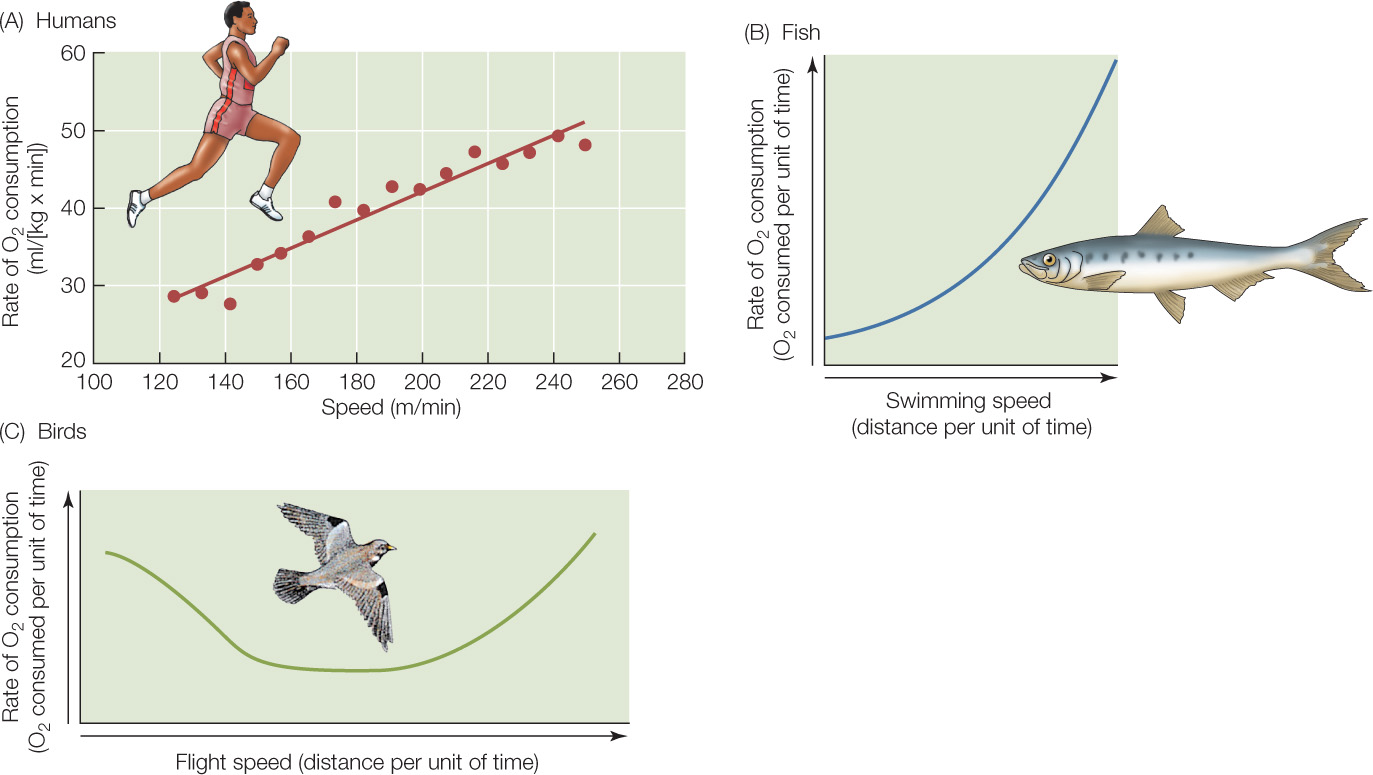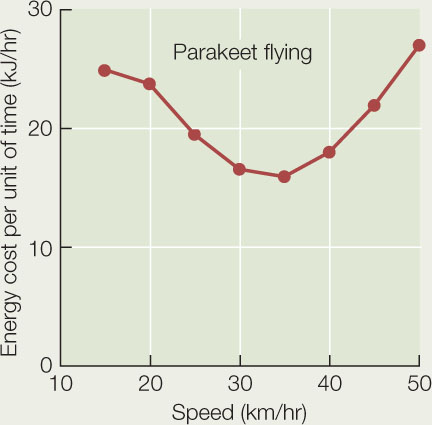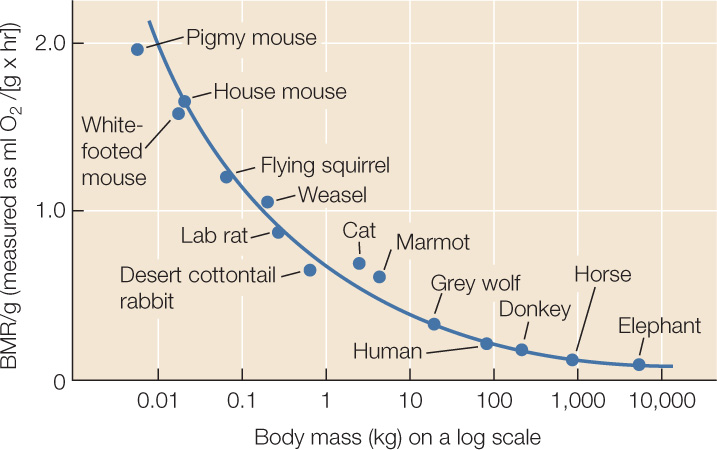Concept 29.2: An Animal’s Energy Needs Depend on Physical Activity and Body Size
How much energy does an animal need? This is a complicated question because animals use energy for many different purposes. Every cell and tissue in an animal’s body uses chemical energy every day to maintain its own internal organized state. Cells and tissues also use energy to do additional types of physiological work. When animals run, for example, their skeletal muscles use energy to generate mechanical forces for locomotion. An animal’s heart muscle uses energy to pump blood. After a meal, the digestive tract uses energy to synthesize digestive enzymes and propel the ingested food through the gut. In this concept we look at how energy use is measured and at two major factors that determine an animal’s total rate of energy use.
We quantify an animal’s metabolic rate by measuring heat production or O{sub}2{/sub} consumption
The word “consumed” is used in more than one way in studying animals. One of its most important uses is in discussing energy. When we say energy is “consumed” by an animal, we mean the energy is converted to heat. Energy cannot be destroyed. However, whereas chemical energy can do physiological work, heat cannot. For this reason, the conversion of chemical energy to heat has a huge consequence: the energy loses its ability to do work for the organism. This is why biologists say that energy converted to heat is “consumed” or used up.
An animal’s metabolic rate is defined as its rate of energy consumption—in other words, the rate at which it consumes chemical energy and converts it to heat. Why are metabolic rates important? The main reason is that when energy is consumed, it needs to be replaced. An animal with a high metabolic rate needs to find and eat a lot of food per unit of time to replace the energy it is consuming. Animals with lower metabolic rates have lower food needs. All living animals have measurable metabolic rates and are found to produce heat when measurements are done with sensitive instruments. Even those animals that do not feel warm to the touch, such as frogs or earthworms, are producing heat. They do not warm up simply because they are losing heat as fast as they produce it.
How can we quantify an animal’s metabolic rate? Because consumed energy becomes heat, one way is to measure an animal’s rate of heat production. But measuring heat production directly is difficult, so biologists usually take advantage of a simple relationship. When organic matter is oxidized during aerobic metabolism, O2 is used as heat is made (see Concept 6.2):
Organic compound + O2 → CO2 + H2O + heat
There is an approximately one-to-one relationship between the rate at which O2 is used and the rate at which heat is produced. To quantify an animal’s metabolic rate, therefore, we can measure its rate of O2 use. Biologists nearly always use this method to quantify metabolic rates. The rate of O2 use is usually called the rate of O2 consumption. Note that in this case “consumption” refers to the combination of O2 with other atoms. Thus “consumption” is being used in a different way than when we talk about energy consumption.
608
Physical activity increases an animal’s metabolic rate
Physical activity often exerts a strong effect on an animal’s metabolic rate. As a general rule, when people and other vertebrates engage in sustained exercise, their metabolic rate increases about tenfold between rest and all-out exertion. FIGURE 29.2A shows the results of a treadmill test—like the one we discussed at the chapter’s start—on several people. When people run, their metabolic rate increases linearly with their speed. This is the usual relationship when animals cover distance by running or walking.

The relationship between speed and metabolic rate is different for animals that swim or fly. When fish swim, their metabolic rate increases exponentially with their speed because the resistance posed by the water increases exponentially with speed (FIGURE 29.2B). Birds show a U-shaped relationship between metabolic rate and speed (FIGURE 29.2C). At low speeds, a bird must maintain a high metabolic rate just to stay airborne. As it speeds up, its metabolic rate decreases because flight is aided by the rapid flow of air over the wings. As the bird flies faster, however, its metabolic rate rises again, because flying at a high speed requires more effort than flying at a medium speed. Airplanes exhibit a similar type of relationship between their rate of energy consumption and speed.
APPLY THE CONCEPT: An animal’s energy needs depend on physical activity and body size
The graph shows the rate of energy consumption—energy cost per unit of time—of a flying parakeet as a function of its horizontal flight speed.a This graph can be used to quantify the energy cost per unit of distance. For assessing the efficiency of our cars, we often focus on miles per gallon. In other words, we focus on how far we can go per unit of energy used. In the graph for the bird, each dot shows the energy cost per unit of time (in kilojoules [kJ] per hour) at a particular speed (in kilometers per hour). Notice that if you divide speed in kilometers per hour by cost in kilojoules per hour, your result will be in kilometers per kilojoule:

In other words, your result will tell you how many kilometers a parakeet can travel for each kilojoule of energy it uses. This is a very similar concept to miles per gallon!
- Calculate the value of kilometers per kilojoule for each of the eight dots on the graph.
- Based on your answer to question 1, what is the best speed for the bird to fly at to cover as much distance as possible per unit of energy used?
aTucker, V. A. 1968. J. Exp. Biol. 48: 67–87.

609
Among related animals, metabolic rate usually varies in a regular way with body size
Species of terrestrial mammals vary in adult body size from about 20 grams in some mice (or even as small as 2 g in some shrews) to more than 5,000 kilograms (5,000,000 g) in elephants. When we look at related animals of widely different body sizes, do their metabolic rates vary in any particular way with their sizes?
To answer this question, we need to measure the metabolic rates of various species under standardized conditions. To standardize the conditions when studying mammals, investigators typically measure the metabolic rates of animals that are in a comfortable thermal environment and resting—and that have not eaten in the recent past. These measurements are called basal metabolic rates or BMRs.
The simplest way to compare the BMRs of mammals of different sizes is to express the rates per unit of body weight. To do this, we take the BMR for each animal and divide it by the animal’s body weight to obtain BMR per gram, or BMR/g.
You might expect that BMR/g would simply be the same in all terrestrial mammals, from mice to elephants, but it isn’t. If you start with mice and look at bigger and bigger species of mammals, BMR/g gets lower and lower. The “mouse-to-elephant” curve shows this (FIGURE 29.3). BMR/g is almost 20 times higher in a mouse than in an elephant. Relationships of this sort—in which animal characteristics are examined as functions of body size—are called scaling relationships.

What are the implications of the scaling relationship between BMR/g and body size in mammals? One thing we can deduce is that small mammals need much more food per gram of body weight than large mammals do—a fact that pet owners and zoo keepers need to keep in mind. Food requirements in relation to body size are also ecologically important. Suppose there are 100 mice and 1 rabbit living in a field or forest. If each mouse weighs 20 g and the rabbit weighs 2,000 g, the mice collectively weigh as much as the rabbit—2,000 g. You might therefore expect that both the mice and the rabbit would eat similar amounts of food each day. However, the mice will in fact eat about three times as much food as the rabbit, because the BMR/g is three times higher in a small mouse than in a medium-size rabbit.
The same type of scaling relationship between metabolic rate per gram and body size (i.e., the same shape as seen in the mouse-to-elephant curve) is seen in almost all types of animals, including crabs, fish, lizards, and birds. Within each group of related species, metabolic rate per gram tends to decrease as body size increases.
CHECKpoint CONCEPT 29.2
- Define “consumption” as it relates to energy in biological systems.
- Which is likely to require more food over a given time period, a group of 60 skates, each weighing 1 kg, or a pair of 30-kg sharks? Skates and sharks both belong to the same group of animals, the cartilaginous fish.
- Biologists sometimes quantify metabolic rates by measuring heat production despite the technical challenges of using this method. Why can an animal’s metabolic rate be quantified by measuring its rate of heat production?
Physical activity and body size are only two of the factors that influence metabolic rates. Now we will look at some of the others.